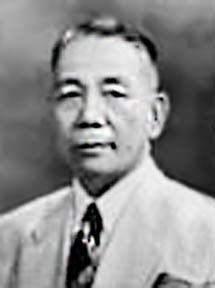Preceded by Jorge B. Vargas Spouse(s) Marta Montes Succeeded by Marcelo T. Boncan Political party KALIBAPI | Preceded by Rafael R. Vilar Name Leon Guinto Children 3 | |
 | ||
Born June 28, 1896
Bacoor, Cavite, Captaincy General of the Philippines ( 1896-06-28 ) Died July 10, 1962, Manila, Philippines Education Colegio de San Juan de Letran | ||
Resting place Manila South Cemetery Succeeded by Hermenegildo Atienza | ||
Leon Gawaran Guinto Sr. (June 28, 1896 – July 10, 1962) was a public servant in the Philippines from the Commonwealth period up to the post-war era, best remembered as the war-time Mayor of the City of Manila in the Philippines.
Contents
Early life
Guinto was born to Juan P. Guinto and Pia Gawaran in the village of San Nicolas in Bacoor, Cavite province. He completed his early education from his home town and earned his college degree from the Colegio de San Juan de Letran. He first got work at the Weather Bureau, married Marta Montes of the town of Atimonan, then Province of Tayabas. The union produced three sons and two daughters.
By 1916, Guinto left his job at the Weather Bureau to pursue law studies at the old Escuela de Derecho and by 1920, after completing his law studies and qualifying as a bona fide lawyer, Guinto was employed as private secretary to the then Philippine Senate President, Manuel L. Quezon.
Pre-World War II
Guinto, after serving briefly as private secretary to Senate President Manuel Quezon, he launched his political career in 1922 by running as member of the Provincial Board of the then Tayabas Province, home province of his wife Marta Montes.
By 1925, he pursued the position of representative of the 2nd district of Tayabas under the Lower House of the Philippine Legislature. He held the post of legislator for six years until 1931.
He was elected governor of Tayabas province in 1931 but his term was cut short when he was appointed as Commissioner of Public Safety by then American Governor-General Theodore Roosevelt Jr. In the later part of 1933, Governor-General Frank Murphy named undersecretary of the Interior Department. By 1934, the Departments of Interior and Labor were merged and Guinto continued to serve as undersecretary.
In 1940, Guinto was appointed Secretary of Labor in the Commonwealth government of President Manuel L. Quezon.
Manila's war-time mayor
By 1942, Guinto was appointed by Jorge B. Vargas, (Chairman of the Japanese created government structure called the Philippine Executive Commission) to assume the position mayor of Greater Manila, and look after the city's administration during the Japanese occupation during the Second World War.
Guinto's close relations with the labor sector proved useful to his administration of Greater Manila, of which a number of labor leaders served as heads of the city government departments.
In 1945, Guinto was indicted as a war criminal for collaborating with the Japanese forces. A blanket amnesty was issued before the granting of Philippine Independence on July 4, 1946, sparing the former Manila mayor of a war crimes trial.
Post World War II
Guinto went into the private sector, taught in the academe and even served as Dean of the College of Arts and Sciences of the Lyceum of the Philippines University.
In 1955, Guinto returned home to Quezon Province and was elected governor, only to lose re-election in 1959.
Guinto died in 1962 at the age of 66.
